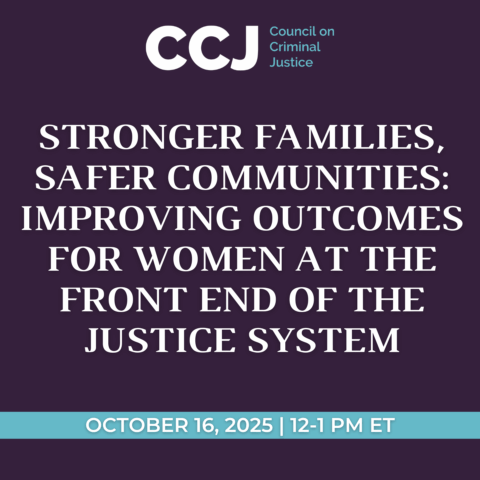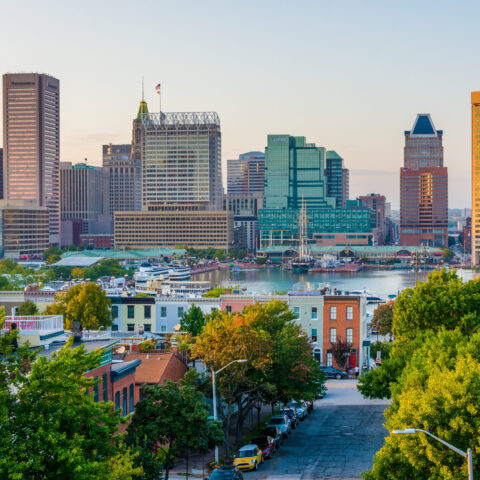Published on October 21, 2025
President Trump announced on October 15, 2025, that he would consider dispatching military troops to San Francisco, CA, in an effort to reduce crime and violence. The deployment would make San Francisco another American city to which the Trump administration has sent, or signaled an intention to send, the National Guard to conduct law enforcement operations.
This brief reviews crime trends in San Francisco using data from the Council on Criminal Justice Mid-Year 2025 Crime Trends report, released in July 2025. That report examined offenses recorded by law enforcement in San Francisco, Baltimore, Washington, Chicago, Memphis, and 37 other American cities from 2018 through June 2025.
From 2019 to 2025, most crime trends in San Francisco are down, with the exceptions of gun assaults, shoplifting, and drug offenses.
- Aggravated assaults for the first half of 2025 were 10% lower, robberies 38% lower, and carjackings 19% lower than the first half of 2019, however gun assaults increased 12% during this period.
- While larceny was down 56% in the first half of 2025 compared to the same period in 2019, shoplifting increased 20% over the same period.
- Drug offenses were 114% higher in the first six months of 2025 compared to the same period in 2019.
- Notably, while motor vehicle theft was up an average of 25% in the first half of 2025 compared to the first half of 2019 in the 36 study cities with data, it was down 17% in San Francisco over the same period.
The charts below present six-month trends for 11 offenses in San Francisco. Monthly counts and rates for San Francisco and other cities in the sample can be explored in the offense dashboard at the bottom of the CCJ Mid-Year 2025 Crime Trends report. Data for homicide and domestic violence crimes collected in other cities were not available for San Francisco.
Please note the following limitations: The cities included in this analysis are not necessarily representative of all jurisdictions in the United States. Not all cities published data for each offense (see the Appendix of the Mid-Year 2025 Crime Trends report for which cities reported which offenses), and trends in offenses with fewer reporting cities should be viewed with extra caution. In addition, not all crimes are reported to law enforcement, and the data collected for this report are subject to revision by local jurisdictions.
Aggravated Assault
Figure 1 shows the reported aggravated assault rate in San Francisco in six-month intervals from January 2018 to June 2025. In the first half of 2025, San Francisco’s aggravated assault rate was 16% lower than in the first half of 2024. The average change in the 23 study cities with data for this crime was -10%.
San Francisco’s aggravated assault rate in the first half of 2025 was 10% lower than in the first half of 2019, while aggravated assault was 5% lower in the study cities.
The highest aggravated assault rate in San Francisco during the first half of the year was in 2022, when the reported rate was 197.3 per 100,000 residents. The rate during the first half of 2025 (149.6) was 24% below that peak.
Figure 1. Aggravated Assault Rates in San Francisco, January 2018 – June 2025
Gun Assault
Gun assaults are a subset of aggravated assaults. Figure 2 shows the reported gun assault rate in San Francisco in six-month intervals from January 2018 to June 2025. In the first half of 2025, San Francisco’s gun assault rate was 12% lower than in the first half of 2024. The average change in the 11 study cities with data for gun assaults was -21%.
San Francisco’s gun assault rate in the first half of 2025 was 12% higher than in the first half of 2019, while gun assaults were 4% lower in the study cities.
The highest gun assault rate in San Francisco during the first half of the year was in 2022, when the reported rate was 30.6 per 100,000 residents. The rate during the first half of 2025 (16.6) was 46% below that peak.
Figure 2. Gun Assault Rates in San Francisco, January 2018 – June 2025
Sexual Assault
Figure 3 shows the reported sexual assault rate in San Francisco in six-month intervals from January 2018 to June 2025. In the first half of 2025, San Francisco’s sexual assault rate was 16% lower than in the first half of 2024. The average change in the 23 study cities with data for this crime was -10%.
San Francisco’s sexual assault rate in the first half of 2025 was 5% lower than in the first half of 2019, while sexual assault was 28% lower in the study cities.
The highest sexual assault rate in San Francisco during the first half of the year was in 2018, when the reported rate was 11.4 per 100,000 residents. The rate during the first half of 2025 (8.3) was 27% below that peak.
Figure 3. Sexual Assault Rates in San Francisco, January 2018 – June 2025
Robbery
Figure 4 shows the reported robbery rate in San Francisco in six-month intervals from January 2018 to June 2025. In the first half of 2025, San Francisco’s robbery rate was 29% lower than in the first half of 2024. The average change in the 34 study cities with data for robbery was -20%.
San Francisco’s robbery rate in the first half of 2025 was 38% lower than in the first half of 2019, while the average reduction was 30% across the study cities.
The highest robbery rate in San Francisco during the first half of the year was in 2018, when the reported rate was 198.1 per 100,000 residents. The rate during the first half of 2025 (110.3) was 44% below that peak.
Figure 4. Robbery Rates in San Francisco, January 2018 – June 2025
Carjacking
Figure 5 shows the reported carjacking rate in San Francisco in six-month intervals from January 2018 to June 2025. In the first half of 2025, San Francisco’s carjacking rate was 53% lower than in the first half of 2024. The average change in the nine study cities providing carjacking data was -24%.
San Francisco’s carjacking rate in the first half of 2025 was 19% lower than in the first half of 2019, while carjacking was 3% lower in the study cities.
The highest carjacking rate in San Francisco during the first half of the year was in 2022, when the reported rate was 15.5 per 100,000 residents. The rate during the first half of 2025 (5.4) was 65% below that peak.
Figure 5. Carjacking Rates in San Francisco, January 2018 – June 2025
Residential Burglary
Figure 6 shows the reported residential burglary rate in San Francisco in six-month intervals from January 2018 to June 2025. In the first half of 2025, San Francisco’s residential burglary rate was 9% lower than in the first half of 2024. The average change in the 18 study cities with data for the crime was -19%.
San Francisco’s residential burglary rate in the first half of 2025 was less than 1% lower (0.4%) than in the first half of 2019, while residential burglary was 47% lower in the study cities.
The highest residential burglary rate in San Francisco during the first half of the year was in 2021, when the reported rate was 206.7 per 100,000 residents. The rate during the first half of 2025 (116.4) was 44% below that peak.
Figure 6. Residential Burglary Rates in San Francisco, January 2018 – June 2025
Non-Residential Burglary
Figure 7 shows the reported non-residential burglary rate in San Francisco in six-month intervals from January 2018 to June 2025. In the first half of 2025, San Francisco’s non-residential burglary rate was 34% lower than in the first half of 2024. The average change in the 16 study cities with data for this crime was -18%.
San Francisco’s non-residential burglary rate in the first half of 2025 was 31% lower than in the first half of 2019, while rates in other study cities were identical to 2019 levels.
The highest non-residential burglary rate in San Francisco during the first half of the year was in 2021, when the reported rate was 357.2 per 100,000 residents. The rate during the first half of 2025 (154.3) was 57% below that peak.
Figure 7. Non-Residential Burglary Rates in San Francisco, January 2018 – June 2025
Larceny
Figure 8 shows the reported larceny rate in San Francisco in six-month intervals from January 2018 to June 2025. In the first half of 2025, San Francisco’s larceny rate was 27% lower than in the first half of 2024. The average change in the 36 study cities with data for larceny was -12%.
San Francisco’s larceny rate in the first half of 2025 was 56% lower than in the first half of 2019, while larceny was 19% lower in the study cities.
The highest larceny rate in San Francisco during the first half of the year was in 2018, when the reported rate was 2,585.0 per 100,000 residents. The rate during the first half of 2025 (1,060.8) was 59% below that peak.
Figure 8. Larceny Rates in San Francisco, January 2018 – June 2025
Shoplifting
Figure 9 shows the reported shoplifting rate in San Francisco in six-month intervals from January 2018 to June 2025. In the first half of 2025, San Francisco’s shoplifting rate was 16% lower than in the first half of 2024. The average change in the 23 study cities with shoplifting data was -12%.
San Francisco’s shoplifting rate in the first half of 2025 was 20% higher than in the first half of 2019, while shoplifting was 4% lower in the study cities.
The highest shoplifting rate in San Francisco during the first half of the year was in 2022, when the reported rate was 232.9 per 100,000 residents. The rate during the first half of 2025 (172.8) was 26% below that peak.
Figure 9. Shoplifting Rates in San Francisco, January 2018 – June 2025
Motor Vehicle Theft
Figure 10 shows the reported motor vehicle theft rate in San Francisco in six-month intervals from January 2018 to June 2025. In the first half of 2025, San Francisco’s motor vehicle theft rate was 45% lower than in the first half of 2024. The average change in the 36 study cities with data for this crime was -25%.
San Francisco’s motor vehicle theft rate in the first half of 2025 was 17% lower than in the first half of 2019, while motor vehicle theft was 25% higher in the study cities.
The highest motor vehicle theft rate in San Francisco during the first half of the year was in 2023, when the reported rate was 475.7 per 100,000 residents. The rate during the first half of 2025 (219.2) was 54% below that peak.
Figure 10. Motor Vehicle Theft Rates in San Francisco, January 2018 – June 2025
Drug Offenses
Figure 11 shows the reported drug offense rate in San Francisco in six-month intervals from January 2018 to June 2025. In the first half of 2025, San Francisco’s drug offense rate was 42% higher in the first half of 2025 than in the first half of 2024. There was no difference in the average rates for the 21 study cities during this period.
San Francisco’s drug offense rate in the first half of 2025 was 114% higher than in the first half of 2019, while drug offenses were 27% lower in the study cities.
The highest drug offense rate in San Francisco during the first half of the year was in 2025 at a rate of 418.4 per 100,000 residents.
Figure 11. Drug Offense Rates in San Francisco, January 2018 – June 2025




